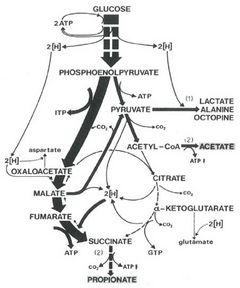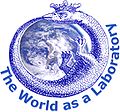Difference between revisions of "Gnaiger 1977 Invertebrate anoxibiosis"
| Line 8: | Line 8: | ||
|mipnetlab=AT Innsbruck Gnaiger E | |mipnetlab=AT Innsbruck Gnaiger E | ||
}} | }} | ||
[[Image:The world as a laboratory.jpg|left|120px|link=http://wiki.oroboros.at/index.php/The_world_as_a_laboratory|Science and adventure]] | |||
* [[Malic enzyme]] | |||
{{Labeling | {{Labeling | ||
|area=Respiration, Comparative MiP;environmental MiP | |area=Respiration, Comparative MiP;environmental MiP | ||
| Line 14: | Line 17: | ||
|preparations=Intact organism | |preparations=Intact organism | ||
|topics=Aerobic glycolysis, ATP, Coupling efficiency;uncoupling | |topics=Aerobic glycolysis, ATP, Coupling efficiency;uncoupling | ||
|additional=Microcalorimetry, Malic enzyme | |additional=Microcalorimetry, Malic enzyme, | ||
MitoFit2022TCA | |||
}} | }} | ||
Revision as of 19:22, 13 February 2022
| Gnaiger E (1977) Thermodynamic considerations of invertebrate anoxibiosis. In: Applications of calorimetry in life sciences. Lamprecht I, Schaarschmidt B (eds), de Gruyter, Berlin:281-303. |
Gnaiger Erich (1977) de Gruyter
Abstract:
New insight into the biochemical mechanism of invertebrate anoxibiosis made possible the calculation of the free-energy changes associated with the generation of high-energy bonds in nucleoside triphosphates (ATP, GTP, ITP) under anoxic conditions. The values obtained are compared with thermodynamic data of aerobic and fermentative energy production, and indicate a selection towards increased energetic efficiency of biochemical pathways leading to less toxic and readily excretable end products in anoxibiotic invertebrates. The thermodynamic model is mainly based upon a metabolic scheme elaborated on intertidal bivalves by de Zwaan et al, benthic oligochaetes and fresh-water bivalves. It may provide a general hypothesis for the energetic processes which operate in a variety of ecological and taxonomic groups of anoxibiotic animals.
• O2k-Network Lab: AT Innsbruck Gnaiger E
Labels: MiParea: Respiration, Comparative MiP;environmental MiP
Stress:Ischemia-reperfusion Organism: Annelids, Molluscs
Preparation: Intact organism
Regulation: Aerobic glycolysis, ATP, Coupling efficiency;uncoupling
Microcalorimetry, Malic enzyme, MitoFit2022TCA


